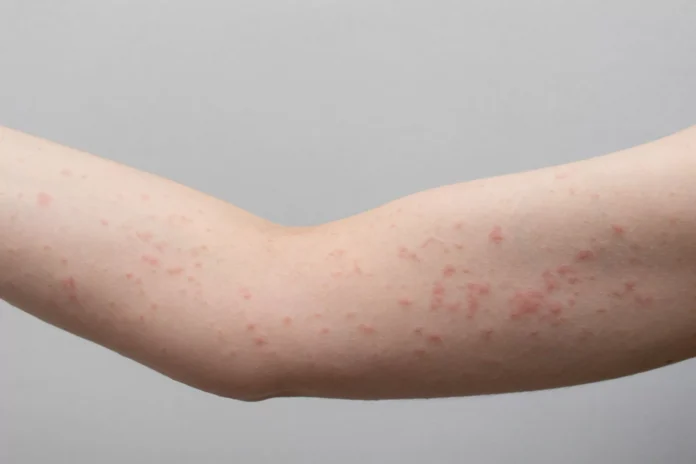You wake up with red, itchy welts on your arms, back, or neck. You didn’t change your soap. You haven’t eaten anything unusual. So why are you breaking out in hives?
Hives — also known as urticaria — are more than just an allergic reaction. While many people assume hives come from food or bug bites, the real triggers can be unexpected, sneaky, and surprisingly common.
The good news? Once you know what might be behind your skin reaction, you can take steps to prevent flare-ups and find relief.
Let’s uncover the common — and surprising — causes of hives you may not have considered.
What Are Hives?
Hives are raised, red, itchy welts that can appear anywhere on the body. They:
- Vary in size — from a pencil eraser to a dinner plate
- Come and go within hours or days
- Are caused by the release of histamine from immune cells in the skin
There are two types:
- Acute hives — last less than 6 weeks (often from allergies)
- Chronic hives — last more than 6 weeks (often no clear cause)
About 20% of people will get hives at least once in their lives.
Common (But Surprising) Triggers of Hives
You know about peanuts and shellfish — but here are lesser-known culprits that may be behind your outbreak.
1. Medications (Even Over-the-Counter Ones)
Home Surprising Causes of Hives Revealed — What May Be Triggering Your Skin Reaction
Surprising Causes of Hives Revealed — What May Be Triggering Your Skin Reaction
Common offenders:
- Antibiotics (especially penicillin)
- NSAIDs (ibuprofen, aspirin)
- Blood pressure medications
Hives can appear hours or days after starting a new drug.
Tip: Always tell your doctor about skin reactions — don’t assume it’s just a rash.
2. Heat, Cold, or Sun Exposure
- Heat hives (cholinergic urticaria): From exercise, hot showers, or stress
- Cold urticaria: Welts after cold water, ice, or winter air
- Solar hives: Reaction to sunlight (rare)
These are physical hives — triggered by environmental changes, not allergens.
3. Stress and Emotional Anxiety
- Stress doesn’t cause hives — but it can trigger or worsen them
- Linked to chronic idiopathic urticaria (hives with no known cause)
- The body’s stress response can overactivate the immune system
“I broke out the night before my big presentation” — a common story.
4. Infections (Yes, Even a Cold)
- Viral infections (like colds, flu, or mono)
- Bacterial infections (like strep throat or UTIs)
- Even dental infections can trigger hives
Especially common in children.
5. Tight or Irritating Clothing
- Synthetic fabrics, waistbands, or bras can cause pressure hives (dermatographism)
- Skin becomes raised and itchy where it’s scratched or rubbed
- Also called “skin writing” — you can literally write on your skin with a fingernail
Affects up to 5% of the population.
6. Foods You Didn’t Expect
Beyond the usual suspects (nuts, shellfish), these can trigger hives:
- Strawberries, tomatoes, citrus fruits — natural histamine releasers
- Food additives — like preservatives (sulfites, benzoates) or artificial colors
- Spicy foods — can worsen existing hives
Tip: Keep a food and symptom journal to spot patterns.
7. Exercise (Exercise-Induced Urticaria)
- Hives appear during or after a workout
- May be linked to food-exercise combos (e.g., eating peanuts before running)
- In rare cases, can lead to anaphylaxis
If this happens, see an allergist — don’t ignore it.
8. Autoimmune Conditions
Chronic hives are sometimes linked to:
- Thyroid disease (especially Hashimoto’s)
- Lupus
- Rheumatoid arthritis
The immune system mistakenly attacks healthy tissue — including skin cells.
Blood tests can help identify underlying issues.
9. Environmental Allergens (Not Just Pollen)
- Dust mites, pet dander, mold, and even latex can cause hives
- Often overlooked because they’re “everyday” exposures
Consider air purifiers or allergy testing if hives are frequent.
10. Hormonal Changes
Hives can flare during:
- Menstruation
- Pregnancy
- Menopause
Hormones can influence immune and skin responses. More common in women than men.
What to Do If You Get Hives
- Don’t Scratch
- Scratching worsens inflammation and can cause infection
- Use cold compresses or calamine lotion to soothe
- Take an Antihistamine
- Over-the-counter options:
- Cetirizine (Zyrtec)
- Loratadine (Claritin)
- Diphenhydramine (Benadryl) — but it causes drowsiness
- Most mild hives resolve within 24–48 hours.
- Over-the-counter options:
When to See a Doctor
Seek medical attention if you have:
- Hives that last more than 6 weeks (chronic urticaria)
- Swelling of the face, lips, or tongue (angioedema)
- Difficulty breathing or dizziness (signs of anaphylaxis)
- Hives with fever, joint pain, or fatigue
A dermatologist or allergist can help identify triggers and manage chronic cases.
Final Thoughts
Hives aren’t just about allergies. They’re a signal from your immune system — one that could be pointing to stress, illness, environment, or even your workout routine.
So if you keep breaking out and don’t know why… take a closer look. Because the trigger might not be in your food — it could be in your clothes, your medicine, or even your emotions. And once you find it, relief is within reach.





